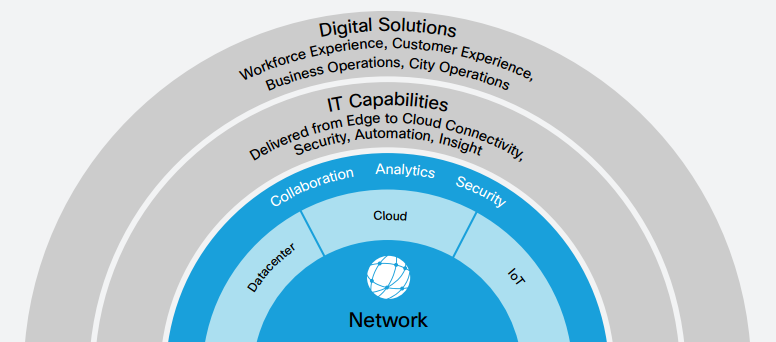
Enabling Mobile Applications with Cisco Digital Network Architecture
Now we are in a digital world and era. But it has never been easier to going digital. How to make it easier? The answer is DNA, Cisco DNA, the most popular solution DNA, not that deoxyribonucleic acid, but the Digital Network Architecture.
Cisco Digital Network Architecture Vision

Cisco DNA was unveiled at Cisco Partner Summit 2016 in March. We talked about it before: Cisco DNA is a Game Changer for the Digital Era?
Now everyone is talking about the Cisco DNA. They discuss the Cisco DNA from different angles. What are your opinions and angles? We’d like to share Chris Oggerino’s reviews on Cisco DNA. He shared some of his favorite things inside Cisco Digital Network Architecture. Let’s have a look.
Cisco DNA (Cisco Digital Network Architecture) automates your network while specializing in its mobility. In short, it is a solution that will change the way you deploy and manage your network for the digital era. Cisco DNA is a software-driven architecture focused on automation, security, and analytics.

The diagram above may not be perfect, but it should suffice to explain this perspective.
Cisco DNA creates a platform that makes it so you can connect everything from the data center to the IoT device, with security and high performance. Furthermore, the parts that are not readily apparent in a network diagram are actually even cooler than the parts you can see. While all of the networking is handled superbly, in typical traditional Cisco fashion, there’s a few extra really interesting things that I want to talk about:
- Cisco Mobile Experiences (CMX)
- Cisco Identity Services Engine (ISE)
- Cisco Application Policy Infrastructure Controller – Enterprise Module (APIC-EM))
Firstly, and my favorite thing in DNA, if you add CMX to this network, you can create indoor location services. Imagine you walk into a big hardware store, and you want to find the electrical expert. Now imagine that you bring up the store’s app, and you see a store map. The map has a blue dot showing where you are and a pull down menu to select what you want. You select “Electrical” and up pops a dot showing where that expert is. You walk up and say, “Hey are you the electrical expert?” And, now you are connected! Fast and efficient, life made easier by a mobile application. Here’s the question: if you didn’t have a Cisco DNA platform, with CMX and its Hyper-Location services, how would you actually do that? Yeah, good luck, their locator feature doesn’t work like this.
Secondly, if you have a mobile application that requires some priority in the network, you can set that up lickity split with APIC-EM. Maybe you want to prioritize video over Wi-Fi inside the app and you want it to be high quality. Or, maybe you just want to push a bunch of data back and forth with high performance. Whatever the reason might be, if you want to make sure that when someone goes from using their phone as a guest, and then logs into your app, that their network traffic gets first-class treatment, APIC-EM can do that for you.
Finally, let’s talk about security. Cisco DNA has a robust set of security features designed into it. One example of that is Cisco Identity Services Engine (ISE). Cisco ISE is easily configured to work with your Mobile Device Management software and it has an API that makes it easy to use from within your mobile application. So, if you want your application to be secure, the DNA platform and its security APIs make that possible. Below, is a diagram of what that might look like.

Moving forward, I’ve just explained three elements of Cisco DNA, which can be utilized by a mobile application to make it more innovative, more secure or higher performance. What do all of these things have in common? They all have the high-level architecture diagram, below, in common. As you can see in the simple diagram, at the bottom of the stack is a Cisco DNA platform. Above that is the “middleware”, depicting the APIs that are part of Cisco DNA. And on top of that, is the application, which makes calls to the various APIs in order to work. Obviously, there are going to be other APIs, like customer databases, which are not part of DNA, required. But this platform, developers, is why you should check out Cisco DevNet – where you can learn all about these APIs.

For me, mobile application development is awesome. In one of my recent blogs, written to describe how partners could accelerate innovation with Cisco DevNet, I brought up this data point: The Global Center for Digital Business Transformation says that about 40% of businesses will fail because of digital disruption by 2020. The full report is available on their web site.

We know this digital disruption is critical. But, what does it look like? Well, the way I see it, mobile applications are the primary way digital transformation is being done. As I’ve shown in other blogs; healthcare, retail and food services are all seeing heavy digitization via mobile applications. Auto insurance companies are also modifying the way you do business with them. I heard a commercial the other day where a woman “moved a tow truck 25 miles with a couple fingers”– using the insurance company’s mobile app to get a tow. At any rate, after 35 years in the technology industry, I’m just loving what companies are doing with their digital transformations – and how mobile applications improve my life.
I’ve discussed three specific APIs built into the Cisco DNA platform, which show how the network can truly be more than just the network. I’ve also shared some data that shows why innovating for your business is going to be crucial over the next few years. And finally, I’ve proposed an idea that this digital transformation is highly likely to need a mobile app. I think that’s adequate reason to see if the Cisco DNA platform might be just what you need to make your mobile application more innovative.
Reference from https://blogs.cisco.com/wireless/enabling-mobile-applications-cisco-digital-network-architecture-ciscodna
More Related…





